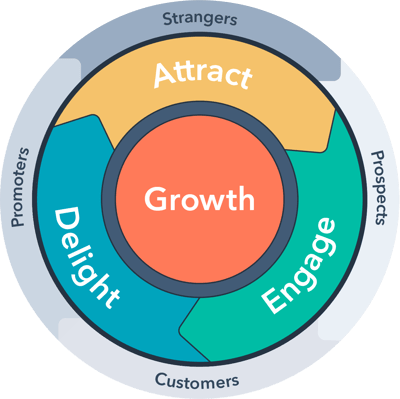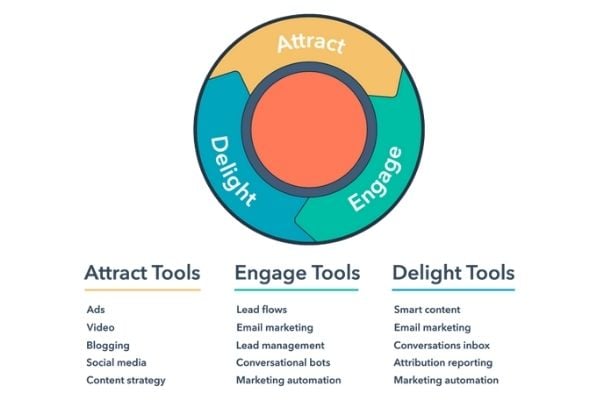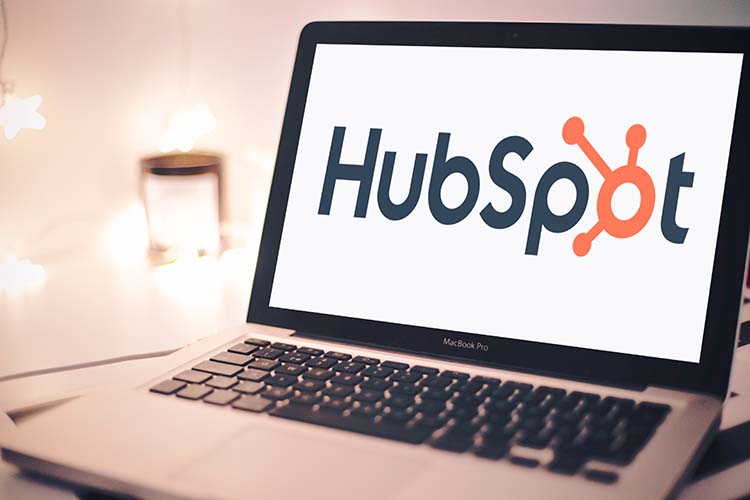Inbound marketing: what is it?
Inbound marketing is the method of attracting customers according to the inbound method. This involves your content addressing the customer's needs rather than imposing your product on them. With inbound marketing, you look at how your product or service provides a solution to your potential customer's problems or challenges. In this blog, we will explain what inbound marketing is and how you can use it for your marketing strategy.
With HubSpot’s inbound marketing method, you attract the right leads, create value-added interactions and continue to support your customers until after they have selected your service. This is referred to as Attract, Engage and Delight. Marketing, sales and service work together to ensure that all parts of the business are closely aligned. Your aim is to make the customer’s experience so good that it ultimately creates growth.
Simply put: in today’s world of inbound marketing, your prospects don’t want to be sold something. They want to gain knowledge and gather information in order to make a smart, informed choice. And through inbound strategies, you can help your prospects get the insights they are looking for.
The inbound marketing method
The inbound marketing method is aimed at building long-term connections with your visitors, prospects and customers. With so many suppliers and competitors, setting your company apart is essential, and one way to achieve this is by supporting your target group with the right offer at all times in their search. After all: when you can help your customer, this also helps you.
So, how do you do that? Attract – engage – delight – repeat. This flywheel or circle is designed to build meaningful relationships that will grow your business by constantly creating new opportunities for sales and service.
Attract: Attracting the right people with valuable content and interactions that mean you are seen as a trusted authority on the specific topic.
Engage: Getting in touch through tools that can start a conversation, such as email, social media and chat. You offer insights and solutions that match their issues. In other words, you offer value the moment they land on one of your channels or pages.
Delight: The consumer is about to make a purchase. In this phase, as an adviser and expert, you offer the customer help and support to make this purchase as successful as possible. It is more important than ever to continue offering value and providing a complete customer experience, including after the purchase.

Strangers become visitors if you offer them the right, relevant content. The same visitors become leads because you show them you are an authority in your field, making them want to leave personal data in exchange for interesting content. If you then want to turn this lead into a customer, you will have to convince them by sending an email at the right time or by offering more in-depth content in another way. Once your customer is convinced, they become true ambassadors because you don't forget them! So, keep writing content for this group and keep them informed. In this way, you increase the chances of people talking about your product enthusiastically and recommending your company to other, new strangers! This completes the circle.
What is an inbound marketing strategy?
The foundation of inbound marketing (as part of your marketing strategy) consists of 5 key components: contacts, buyer personas, buyer journeys, content and goal setting.
Contacts
Your customers form the basis of your CRM. This is the database where all your customers’ data is stored and where you can also see what interactions they have had with your company (e.g. downloads, forms, emails, contact with support). If these customers are happy, they are also more likely to recommend your product or service to others. This is why it is important to include this customer feedback in your strategy: it is an essential component! By properly mapping out the customer journey, you can also better tailor your marketing, sales and service to new prospects.
Buyer persona
You don't just want to attract random people to your website; they should preferably also be relevant to your business. This is why it is important to gain insight into who your ideal customer or Buyer Persona is. Who has the greatest chance of becoming a lead and eventually even a satisfied customer? Buyer personas are semi-fictional representations of an ideal customer, based on real data and also some educated speculation about demographics, behaviour, motivations and goals.
The customer journey
It is also not enough just to know who you want to reach. You also want to know what they want to see. Each moment your buyer persona comes into contact with your company should be tailored to where your buyer persona is at that moment in their personal customer journey. The buyer journey can be seen as the active search process that someone goes through before making a purchase. Instead of talking about the top, middle and bottom of the funnel, you talk about the awareness phase, consideration phase and decision phase. Everyone moves along this type of path. It starts with a search for a solution to a problem, proceeding to finding potential solutions, and actually buying and thus solving the problem.
The awareness phase
At this stage, your prospect is not yet fully aware of their problem. They start investigating in order to understand certain symptoms of problems or opportunities, or even just to give it a name.
The consideration phase
The consideration phase is when the prospect has a clear definition to further understand the problem or opportunity. They are determined to find out everything and understand what methods are available to solve the defined problem.
The decision phase
In this phase, the prospect takes a look at what sellers and suppliers are out there. This phase is about making a choice. A long list becomes a short list, leading up to the final purchase decision.
The most important thing is that you offer content on your website for every moment in this customer journey. Each different phase requires different content.
Content
When you talk about inbound, you have to talk about your content marketing strategy. In other words, it is important to create content that stands out and is written as much as possible for your specific buyer persona. After all, your content is your marketing toolkit. It includes blogs, interactive tools, photos, infographics, videos, e-books and presentations. Each stage in the buyer journey requires a different approach and, therefore, a different content type. So, think carefully in advance about the kinds of content that suit your buyer persona and their phase. There is nothing wrong with taking your time to think about this: content can really make the difference between a good website and a mediocre one.
Objectives
An inbound marketing campaign without goals is like peanut butter without jelly: tasty, but not quite there. Before you start laying down your plans, you may want to formulate what you want to achieve specifically. Do you want more newsletter subscribers? People registering for a webinar? More visitors to your website after a certain period? Or simply more sales? Without goals, you cannot properly measure the impact of your campaign, making it difficult to say whether a campaign was actually successful. In other words, goal setting is one of the fundamental components of inbound marketing. It ensures that you know what you are working towards and creates more internal unity between marketing and sales teams. So, work with concrete goals that show how marketing contributes to achieving the goals within your company.

Want to know if inbound marketing or HubSpot is for you?
You may also like

Generating leads with inbound marketing

Why do you need to get started with Account-Based Marketing (ABM)?


